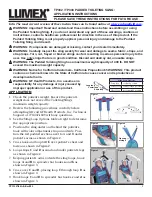
2
Liko • w w w . l i k o . com
Liko Silhouette Sling • 7EN160137-01
Liko Silhouette Sling
Lifting from/to a horizontal position
Turn the patient towards you to prevent him/her from fall-
ing out of the bed. Place the lower edge of the sling as far
down under the patient as possible, so that it is
level with
the tailbone
. The edge of the head support should not be
lower than the head, so as to provide sufficient support to
the head during the lifting operation.
Gather the sling together in a couple of folds and lay it so
that the centre of the sling corresponds to the position of
the patient’s spine when he/she is gently turned back.
Carefully work the sling out from the opposite side.
Raise the bed’s headrest/backrest to a reclining position.
Connect the strap loops as described on page: 3.
Smooth out the leg supports under the legs.
Important!
If the bed is not equipped with an adjustable
headrest/backrest, particular care must be taken during the
initial phase of lifting to prevent strain on the neck.
The assisting caregiver should support the neck manually
during the lift.
Stand in front of the wheelchair to pre-
vent the patient from falling forward.
Lean the patient forward and guide
the lower edge of the sling down to the
level of the tailbone/wheelchair seat.
Head support loop
Size marking
Serial number
Label
Head support
Torso loop
Lower edge
Leg support
Leg support loop
Lifting from a seated position
When lifting from a horizontal position, the easiest way to apply the sling is with the patient in a fully recumbent position,
though in some cases it may be more appropriate to apply the sling while the patient is sitting up in bed.
Follow the instructions below. Lifting to a horizontal position is done in the reverse order.
Remember to lower the headrest/backrest on the bed to avoid discomfort to the neck.
When lifting a patient who requires head support from a sitting position it is usually necessary to lean the patient forward in
order to apply the sling. Remember to apply the wheelchair brake.
Make sure the lower edge of the sling
is pressed against the wheelchair seat
around he patient’s thighs and buttocks.
Pull the leg supports forward, first on
one side, then on the other.
Helpful hint:
Applying light pressure to
the kneecaps will allow you to extend
the leg supports and smooth out any
creases near the back. Make sure both
leg supports reach equally far forward.
Before lifting, remember the following:
• The need for one or more caregivers must be determined
from case to case.
• Plan the lift carefully to ensure that it is performed as safely
and conveniently as possible.
• Although Liko’s slingbars are equipped with safety latches,
particular care should be taken. Before the patient is lifted
from the underlying surface, but after the straps have been
fully extended, make sure the straps are properly hooked to
the slingbar.
• Never lift a patient higher than is necessary for the lifting and
transfer procedure.
• Never leave a patient unattended during a lifting situation.
• Make sure the wheels on the bed, gurney, etc. are locked
during the lifting/transfer operation.









